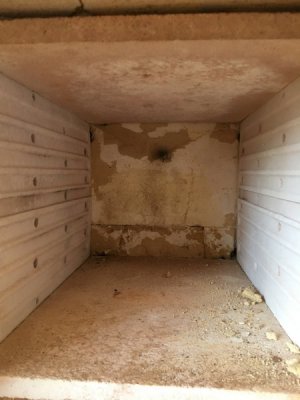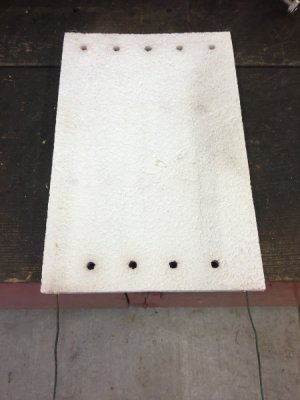-
Welcome back Guest! Did you know you can mentor other members here at H-M? If not, please check out our Relaunch of Hobby Machinist Mentoring Program!
You are using an out of date browser. It may not display this or other websites correctly.
You should upgrade or use an alternative browser.
You should upgrade or use an alternative browser.
208 V single phase?
- Thread starter T. J.
- Start date
- Joined
- Nov 23, 2013
- Messages
- 593
You only need a 7.5 kva since the transformer only carries part of the load. Still about $125.A 32 volt bucking capable of carrying 28 amps will be around 900 watts. A substantial transformer. New cost would be close to $200.
http://www.newark.com/hammond/1182u30/transformer-toroid-60v-1kva/dp/54X7560
- Joined
- Feb 1, 2015
- Messages
- 9,574
The muffle furnace is rated at 3.8 kva. I calculated the power requirement for a bucking transformer from the bucking voltage x the rated current draw; 32 volts x 28 amps = 896 watts.You only need a 7.5 kva since the transformer only carries part of the load. Still about $125.
- Joined
- Nov 23, 2013
- Messages
- 593
- Joined
- Feb 13, 2017
- Messages
- 2,138
I'm a little more awake now. And I know I ain't supposed to do this .... Go to www.hudsontelcom.com There will be a link to an article on "Home Shop Electrics" that will contain the diagrams / schematics for a buck-boost transformer.
This article will be for boosting 208 volts to 240. The same connections will be used, but the connections will be on the inside rather than the outside. The article is long, nearly fifty pages. Look toward the back end for buck-boost usage.
Correction: It is a little over half way in.
I realize I'm being a little cryptic here, I apologize. The article was written over 15 years ago and I've had a few strokes since. I would trust the article more than I would trust me now.
This article will be for boosting 208 volts to 240. The same connections will be used, but the connections will be on the inside rather than the outside. The article is long, nearly fifty pages. Look toward the back end for buck-boost usage.
Correction: It is a little over half way in.
I realize I'm being a little cryptic here, I apologize. The article was written over 15 years ago and I've had a few strokes since. I would trust the article more than I would trust me now.
Bill Hudson
Last edited:
- Joined
- Feb 1, 2015
- Messages
- 9,574
Firstly, the nameplate shows an operating voltage of 208 and a current of 28 amps. This would calculate to 5700 watts. The nameplate also states 3800 watts. Looking at ThermoFisher specifications for current products, it appear that the 5700 watt rating would be correct. I thought at first that the current rating may have been maximum inrush current but most of the common resistance heating alloys have resistance increases of less than 10% at 1200ºC. I would assume that the current specification was the correct value unless additional information proved otherwise.
My idea was to have a separate 32 volt transformer running from the 240 volt line and wired in series with the muffle furnace so the 32 volts was out of phase with the 240 volt line voltage. According to Schneider's selection guide, their transformers are rated as isolation transformers and a transformer operating in buck/boost mode can service a load of 7.5 times the name plate rating (240/32, in this case). A 1 kva 240/32 volt transformer should do the job.
https://www.schneider-electric.us/en/faqs/FA91925/
http://download.schneider-electric....1570.78723956.1532274532-224319235.1532274532
- Joined
- Jun 12, 2014
- Messages
- 4,806
The heating elements voltage is specific to the model, so the 1738 is the 208V version and the 1740 is the 240V single phase version. They both have the same oven dimensions, but the replacement heating elements are different. The elements are in series, so when one fails the other will not function. The 1738 takes two pairs of EL9X5/EL9X4 elements the 1740 takes two pairs of EL9X3/EL9X4 elements, top and bottom elements and a pair of side elements. What may be the overriding factor is the replacement cost of the elements range between ~400-800 each. So at a minimum if you were to replace all 4 elements to 240V type, you are looking at ~$2000 to replace 4 elements for 240V operation.
Models and specifications:
https://store.clarksonlab.com/FA1738.aspx
Models and specifications:
https://store.clarksonlab.com/FA1738.aspx
Attachments
- Joined
- Feb 8, 2014
- Messages
- 11,144
If I were going to replace coils, I would look at something like this https://www.grainger.com/product/SU..._on_Your_Search-_-IDPPLARECS&cm_vc=IDPPLARECS
- Joined
- Oct 31, 2015
- Messages
- 462
I haven't had time to digest all of the good info y'all are providing this morning, but I have tinkered with the furnace some.
I started by sanding the oxidation off of the heating element leads and rechecking them. It turns out that only one is bad. The other three all have a resistance of 7.8 - 7.9 ohms. The bad one is melted in two where the lead comes thru the firebrick at back of the furnace. I'm going to pull it out and see if it's possible to repair it. I've read that it's possible to solder this type of wire with special flux and solder. I'm asssuming this is Kanthal wire.
The reason why the replacement elements are so expensive is that they are embedded in a thin refractory brick. So they are not directly exposed to the interior of the heating chamber. If replacement is necessary, I think I will try using an inexpensive "regular" element. I would just need to find a way to support it.
I started by sanding the oxidation off of the heating element leads and rechecking them. It turns out that only one is bad. The other three all have a resistance of 7.8 - 7.9 ohms. The bad one is melted in two where the lead comes thru the firebrick at back of the furnace. I'm going to pull it out and see if it's possible to repair it. I've read that it's possible to solder this type of wire with special flux and solder. I'm asssuming this is Kanthal wire.
The reason why the replacement elements are so expensive is that they are embedded in a thin refractory brick. So they are not directly exposed to the interior of the heating chamber. If replacement is necessary, I think I will try using an inexpensive "regular" element. I would just need to find a way to support it.
- Joined
- Oct 31, 2015
- Messages
- 462
Here's the inside of the furnace. The bad element is on the left.

I just got it pulled out. This is a pic of the back side.

I checked the element and the portion embedded in the brick seems good. I just need to attach enough wire to the broken lead to reach all the way through the back of the furnace.

I just got it pulled out. This is a pic of the back side.

I checked the element and the portion embedded in the brick seems good. I just need to attach enough wire to the broken lead to reach all the way through the back of the furnace.

